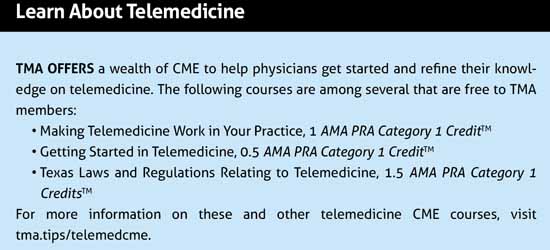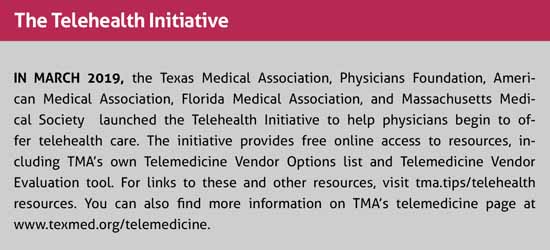
Thanks in large part to COVID-19, telemedicine has arrived. Where does it go from here?
That was much of the focus of a Telehealth Virtual Bootcamp, an Aug. 29 presentation by the Telehealth Initiative that touched on technology, applications, and payment.
The Telehealth Initiative, of which the Texas Medical Association is a member, launched earlier this year to help physicians get started on telemedicine. (See “The Telehealth Initiative,” page 31.)
Following the onset of the pandemic, “telehealth” has become a household word even outside the health care community, Joseph Kvedar, MD, president of the American Telemedicine Association, said in the boot camp’s keynote speech, “The Future of Virtual Care.” That familiarity is “huge” for moving the telemedicine industry forward, he noted.
“The one thing that we can all say we have achieved at this point is we’ve brought the doctor’s office into the home successfully,” Dr. Kvedar said. “And we should be proud of that, because a lot of things could have gone wrong, and not many really did. We’ve done some pretty good research on that and not found any real issues with untoward events or problems.”
One attendee at the live presentation of the boot camp, Round Rock family physician Tina Philip, DO, opened her own solo practice in mid-March, just as the entire nation was on the verge of shutdown. Like many physicians, she had to learn as she went about how telemedicine worked.
Dr. Philip was particularly impressed by the boot camp’s detail on the potential of telemedicine beyond patient visits.
“That was probably the most helpful thing, [acknowledging], ‘There’s some other things we can do here. We’re seeing patients, but what other things can we use this technology for to offer patients that maybe we weren’t offering before, make things a little bit more convenient, be able to touch more patients with the technology?’ That was probably one of the bigger takeaways,” she said.
A “one to many” model
Clinicians now have the opportunity to reimagine health care delivery, Dr. Kvedar said, adding that the real goal of telehealth is a “one-to-many” care model – versus one-to-one physician-patient interactions – to serve more patients and improve efficiency.
In that regard, one telehealth trend that medicine will see is what he described as more “asynchronous” activity – that is, receiving patient data like a health history or a photo offline so clinicians can evaluate it at a more convenient time, versus online during a live telemedicine visit.
“Why? Well, because it’s efficient, because we can get a lot done that way. … Because you can do it like an email,” Dr. Kvedar said. “Think about how much more efficient handling email is than having everything by audio call or video call, and you’ll get a sense of how asynchronous can be really powerful.”
Without a “one-to-many” care model, he warned, the health care system won’t be able to tackle the demand for services much longer.
“How can we use things like software, chat bots, [augmented intelligence], other health care professionals than doctors, nurses, to get our patient care in a way that so many other service industries have already done?” Dr. Kvedar asked. “Whether it’s flagging a ride by Uber or having food delivered to your door, you have a digital front end, and then there’s human-being services somewhere in there.”
Other telehealth trends on the horizon, he predicted, include more use of home devices, home laboratory testing, and digital biomarkers (such as software that can detect a respiratory illness when a patient coughs).

Remote patient monitoring
For instance, boot camp participants received some novice training in remote patient monitoring (RPM), thanks to Yvonne Mounkhoune, TMA’s quality practice management consultant, and Bissan Biary, senior practice solutions specialist at the Massachusetts Medical Society.
RPM technology augments telehealth with devices that can remotely measure a patient’s weight, blood pressure, and more.
Such tools have provided a number of improvements in patient care, including increased medication compliance, Ms. Mounkhoune said. Technological innovations have developed exponentially in that area, such as special containers that communicate to a home health company whether patients have accessed their pill box to take their medication.
Remote patient monitoring also can be useful for reducing hospitalizations, readmissions, and emergency department (ED) visits: “You can prioritize who needs to be contacted first, who needs a home health visit, who needs to come into the office, who needs to go to the [ED], things like that,” and intervention in real time can hopefully avoid hospital admissions and ED visits, she added.
Some of the challenges, however, include the need for patient engagement and acceptance of the devices required, as well as broadband connectivity issues in rural and underserved areas, she cautioned.
Ms. Biary broke down the clinical roles and responsibilities RPM requires, and how to partner with the patient to make the technology work.
“Patient engagement is essential to maximize the impact of your RPM program, because many RPM program solutions require daily active participation from your patient,” she said. “So our goal is to build [a] strong personal connection between the RPM team and the patient, and give that sense of dedicated clinical support to them when they need it.”
A four-physician panel moderated by Kate Kirley, MD, director of chronic disease prevention at the American Medical Association (AMA), examined using telehealth and RPM in practice. Panelists weighed in on what types of practices and conditions work well with telehealth, as well as tips and tricks for success.
For example, Larry Garber, MD, medical director for informatics at Reliant Medical Group, based in Massachusetts, noted that physicians doing a remote visit should ask patients to close other programs or apps to reduce bandwidth usage. Physicians also should refrain from moving their hands around a lot, because that uses bandwidth, too.

Payment concerns
Another panel discussion looked at quality and payment-model implications for telemedicine. Carol Vargo, director of practice sustainability at AMA, said adequate payments are essential to support practices’ spending on the required telehealth infrastructure for remote care.
“I think now, people are pulling back and trying to look at where the evidence lies, what the best practices are, with regard to reimbursement,” Dr. Vargo said. “There is absolutely a keen interest [in] advancing telehealth in the context of value-based care and value-based contracting. I think that will continue to increase.”
Houston gastroenterologist Keith Fernandez, MD, chief clinical officer at Privia Health, said many payers are reluctant “about all of this virtual business being persistent into the future,” but medical groups need to convince them it’s effective. For instance, Privia partnered with several payers during the pandemic to become a “backup” virtual provider, augmenting the payer’s existing relationship with other telehealth organizations.
“There are many ways to partner; we want to partner,” he said. “The best way to partner is to get into a risk relationship. Because it’s meaningful for both sides then.”
Tex Med. 2020;116(11):30-33
November 2020 Texas Medicine Contents
Texas Medicine Main Page